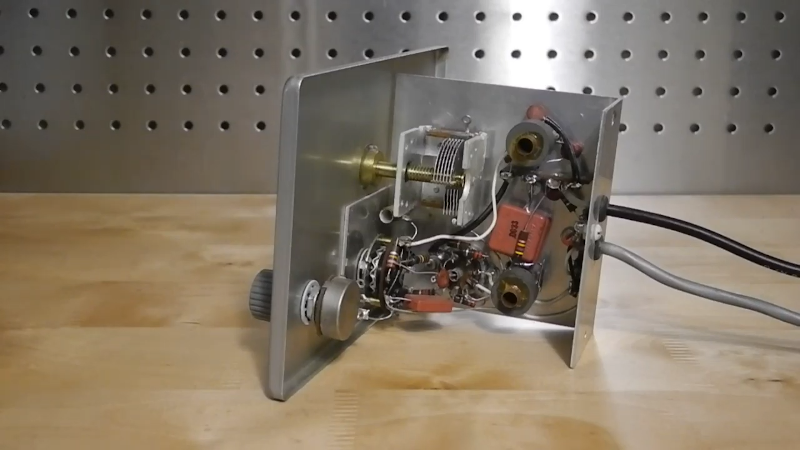If you are below a certain age, you’ve probably never heard of a Q multiplier. This is a device that increases the “Q” of a radio receiver’s intermediate frequency and, thus, provide a higher selectivity. If you enjoy nostalgia, you can see inside a 1960s-era Heathkit QF-1 Q multiplier in [Jeff’s] informative video, below.
The Q multiplier was a regenerative amplifier that operated at just below the oscillation point. This provided very high amplification for the frequency of interest and less amplification for other frequencies. Some radios had a stage like this built-in, but the QF-1 was made to add into an external radio. For some Heathkit receivers, there was a direct plug to tap into the IF stage for this purpose. Othe radios would require some hacking to get it to work.
The QF-1 had several modes of operation where it could act as bandpass filter or a notch filter. You could also tune the frequency using the main knob. The circuit when revealed isn’t overly complex and there is no printed circuit board. The active device was a dual triode.
If you want a deeper discussion of the circuit, the Orange County Amateur Radio Club newletter a few years back had a great article on this device by [AF6C]. It explains how each mode works. It also mentions a few of the device’s offspring such as the HD-11 and GD-125, which was sold until 1971.
If you have plans of building a circuit like this, keep in mind that the intermediate frequency for most radios in those days was 455 kHz, which is what the QF-1 expects. Most communication receivers today use significantly higher IF for a variety of reasons (10.7 MHz, for example, is common).
We always enjoy [Jeff’s] videos of old receivers and gear. Not that he’s the only one doing things like that.
















Not allowed to talk about “Q”
I see what you did there. Well done, sir.
Yeah, I’d need something to filter out all the “Q” on my radio, certain frequencies, anyways.
Ask Miss Moneypenny for propah permission!
Funny how I want to an entirely different Q… but this one works as well.
The Q-multiplier was connected with a single wire to the IF stage, usually the plate of the mixer. Hence an external could be connected via a jack.
It was about boosting the Q (and hence selectivity) of a tuned circuit, rather than amplification. It was a cheap and easy way to add selectivity to a low end receiver. Though done right, there were advantages for better receivers.
Selectivity was good, but it didn’t do much for skirt selectivity.
The process was like a regenerative receiver.
Some cheap receivers just added feedback around the IF stage, with a control for regen. Turn that up and it would oscillate, so no need for an extra BFO stage.
The Q-multiplier was described in the late firties (at least as an add-on) in Electronics or Electronic World. I forget the details. But it showed a much.more complicated circuit, and detailed all kinds of uses.
A lot of receivers, at least with an IF rather than DSP, still use 455 or 450KHz IFs. It’s just that that is now the second IF.
There was some use of Q-multipliers at front end frequencies, to improve image rejection. But it’s been pointed out that for ultimate selectivity, the higher you go the less selectivity you can get. Not a surprise, a coil at 455KHz has better selectivity than one at 4MHz.
It’s an interesting point. When the regen came along, radio was at very low frequencies, moving up as need expanded. So early use of regens was around 450KHz. Most people after WWII used regens at much higher frequencies.
“A lot of receivers, at least with an IF rather than DSP, still use 455 or 450KHz IFs. It’s just that that is now the second IF.”
IIRC, 455Kc (ha-ha) was used for the AM broadcast band, and when AM-FM radios came about, it was easier to downconvert the FM band down to the AM IF, and use those stages to feed the AF circuit.
Jeff Tranter has one of my favorite channels on youtube. He is clear, concise, and has a lot of great material on heathkit models.
Totally worth your time if you are into that sort of thing.
But boy, if you turned it up too high, it squealed like a stuck pig!
I that a Q multiplier was called YouTube?
The ‘Q’ continuum!
This post put me on a guilt trip: https://soldersmoke.blogspot.com/2021/01/guilt-trip-video-on-heath-qf-1-q.html
My hammerlund hq100 and hq160 have built in Q multi. Hi end recievers of the day would use 455 kc first if and 85 or 50 kc 2nd. I used an arc5 as a second if 455 down to 85 lc for my s40b, that was a common mod also